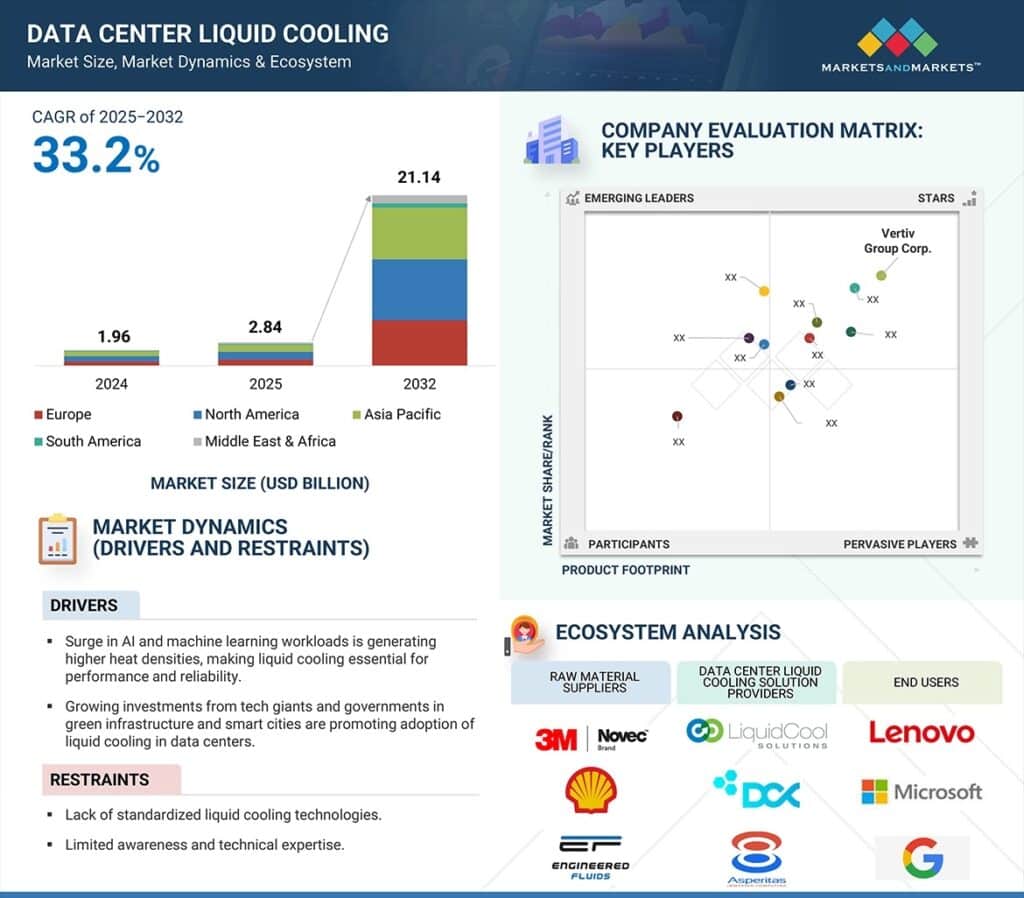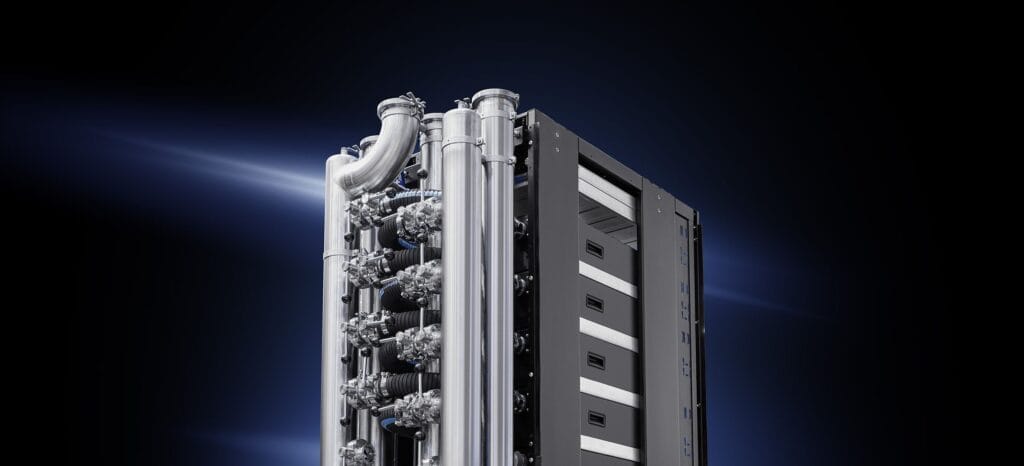Sure! Here’s the translated text in American English:
—
The liquid cooling sector in data centers is experiencing accelerated growth due to the demand for more efficient and sustainable cooling solutions.
The global liquid cooling market for data centers is expected to reach a value of $21.14 billion by 2032, with a compound annual growth rate (CAGR) of 33.2% from 2025 to 2032, according to an exclusive report from MarketsandMarkets™. This growth is primarily driven by the increasing demand for artificial intelligence (AI)-based applications, cloud computing, and high-performance computing (HPC), which makes traditional cooling systems like air conditioning ineffective in many data center environments.
Driven by High Server Density and Energy Efficiency
As server density increases in data centers, traditional air cooling systems are becoming obsolete. Liquid cooling solutions, such as immersion cooling, direct-to-chip cooling (DTC), and cold plate cooling, have become essential for managing the high thermal loads of modern data centers, which now process vast volumes of data generated by IoT devices, artificial intelligence, and cloud applications.
Liquid cooling offers several advantages over traditional air systems, such as higher energy efficiency, lower operating costs, and better capacity to cool high-density environments. These technologies not only optimize space utilization in data centers but also improve sustainability by reducing energy consumption and carbon emissions, which is particularly relevant in a context of increasing pressure from environmental regulations and initiatives to create greener infrastructure.
Expanding Segments: Hyperscale Data Centers and Small and Medium-Sized Data Centers

The MarketsandMarkets™ report highlights two specific segments that are driving the adoption of liquid cooling in data centers: hyperscale data centers and small and medium-sized data centers (SMB).
- Hyperscale Data Centers: These data centers, operated by tech giants like Amazon Web Services (AWS), Google, Microsoft, and Meta, are rapidly adopting liquid cooling due to the increasing demand for applications that require massive processing capacity, such as artificial intelligence and big data analytics. This segment is expected to remain the largest in terms of growth in the liquid cooling market until 2032.
- Small and Medium-Sized Data Centers: Concurrently, smaller data centers, which are becoming increasingly common due to the trend of edge computing and localized infrastructure, are also rapidly adopting liquid cooling solutions. This is especially true in sectors such as healthcare, retail, and education, where data centers need to be compact, efficient, and capable of handling high thermal loads. The ease of installation and reduced costs of modular liquid cooling solutions have facilitated their adoption in these environments.
Growth in North America and Asia-Pacific
The North America region is leading the liquid cooling market in data centers, with strong growth driven by the adoption of advanced technologies such as artificial intelligence and cloud computing. In particular, cloud service providers like Google, AWS, and Microsoft are heavily investing in liquid cooling technologies to enhance the energy efficiency of their data centers.
On the other hand, the Asia-Pacific region is experiencing rapid growth in the liquid cooling market due to the expansion of digital infrastructure driven by increasing demand for cloud services, 5G, and AI-based applications. Countries like China, Japan, and India are quickly adopting liquid cooling solutions to address the growing data demands and the need for more sustainable IT infrastructures.
Innovations in Liquid Cooling Technology
Innovations in dielectric fluids and two-phase cooling are transforming the liquid cooling market, establishing companies like Green Revolution Cooling (GRC), Iceotope, and LiquidStack as new industry standards. These advanced technologies enable more efficient and safe cooling of servers, increasing reliability and reducing long-term operating costs.
Challenges and Opportunities
While liquid cooling promises superior efficiency, it also faces certain challenges, such as high initial costs and risks associated with maintaining systems, such as potential leaks or sedimentation issues. However, with the evolution of materials and system designs, the adoption of liquid cooling solutions is gaining traction, especially among companies striving to meet energy efficiency and sustainability regulations.
The liquid cooling market for data centers is advancing rapidly and is expected to continue its expansion, driven by the growing need for more efficient cooling solutions in a high-performance and energy-intensive environment.
Conclusion
The global liquid cooling market for data centers is in full expansion, with growth expected to rise from USD 2.84 billion in 2025 to USD 21.14 billion in 2032. The adoption of liquid cooling technologies is being driven by the increasing demand for more efficient and sustainable IT solutions in an ever-more interconnected digital world. As companies seek to reduce operational costs and improve performance, liquid cooling emerges as a key component of future infrastructure.
The next few years will be crucial in determining how liquid cooling solutions continue to play a fundamental role in the development of high-performance and sustainable data centers, both in developed and emerging markets.
Reference: Market and Markets

